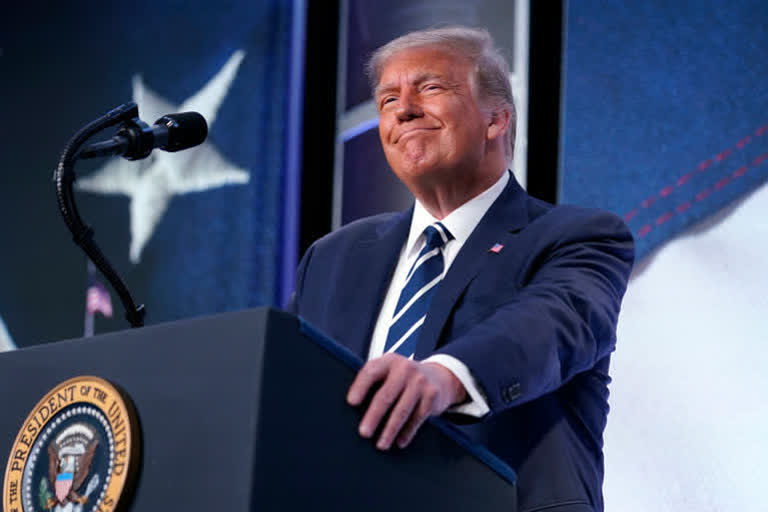Chicago: On a recruiting trip to India's tech hub of Bangalore, Alan Cramb, the president of a reputable Chicago University, answered questions not just about dorms or tuition but also American work visas.
The session with parents fell in the chaotic first months of Donald Trump's presidency. After an inaugural address proclaiming 'America first', two travel bans, a suspended refugee programme and hints at restricting skilled worker visas widely used by Indians, parents doubted their children's futures in the US.
Nothing is happening here that isn't being watched or interpreted around the world, said Cramb, who leads the Illinois Institute of Technology, where international scholars have been half the student body.
America was considered the premier destination for international students, with the promise of top-notch universities and unrivalled job opportunities. Yet, 2016 marked the start of a steep decline of new enrollees, something expected to continue with fresh rules limiting student visas, competition from other countries and a haphazard coronavirus response.
The effect on the workforce will be considerable, experts predict, no matter the outcome of November's election. Trump has arguably changed the immigration system more than any US president, thrilling supporters with a nationalist message and infuriating critics who call the approach to his signature issue insular, xenophobic and even racist.
Before the election, The Associated Press is examining some of his immigration policies, including restrictions on international students. For colleges that fear dwindling tuition and companies that worry about losing talent, the broader impact is harder to quantify: America seemingly losing its luster on a global stage.
It's not as attractive as it once was, said Dodeye Ewa, who's finishing high school in Calabar, Nigeria. Unlike two older siblings who left for US schools, the aspiring pediatrician is focused on Canada. In America, she fears bullying for being an international student and a Black woman.
Roughly 5.3 million students study outside their home countries, a number that's more than doubled since 2001. But the US share dropped from 28% in 2001 to 21% last year, according to the Association of International Educators, or NAFSA.
New international students in America have declined for three straight years: a 3% drop in the 2016 school year the first in about a decade followed by 7% and 1% dips, according to the Institute of International Education, which releases an annual November report.
READ: Pakistan could be next polio-free country: WHO
The National Student Clearinghouse Research Centre's fall snapshot shows a 13.7% drop in undergraduate international students. The government cites high college costs, but students tell another story.
I feel I am more comfortable in my home country, said Priyadharshini Alagiri, 22, of India, who's pursuing a master's in electrical and computer engineering at IIT.
The Chicago university known for engineering, computer science and architecture saw a 25% decline in international students from fall 2016 to fall 2018. Alagiri said the pandemic exacerbated things, including a short-lived Trump administration rule requiring international students to leave if their schools held online-only classes. Students panicked, universities protested and lawsuits followed.
The Trump administration has floated curtailing Optional Practical Training, a popular programme allowing international students to work. Roughly 223,000 participated in 2018-19, according to the Institute of International Education.
This month, the administration announced plans to limit H1-B skilled-worker visas, often a path for foreign students. It was pitched as a way to address pandemic-related job losses, following a June order temporarily suspending H1-Bs. It's prompted a lawsuit.
Nearly 60% of US colleges reported the social and political environment contributed to the decline of new international students, according to a 2019 Institute of International Education survey.
Most colleges in the survey said the difficulty in obtaining US visas was also to blame. Student visas issued under Trump shrunk 42%, from nearly 700,000 in 2015 to under 400,000 last year, according to the State Department.
There are signs of waning interest in America in India, which with China, provides the most international students globally. In 2018, about 90% of Indians studying abroad chose the US, with fewer than 5% in Canada. For the 2021 school year, roughly 77% plan to study in America, and nearly 14% chose Canada.
READ: Netanyahu hails Israel-Sudan normalisation deal
That's according to a survey by Yocket, a Mumbai-based startup helping roughly 400,000 Indian students plan study abroad. Yocket co-founder Sumeet Jain said there's still wide belief America is unmatched for science, technology, engineering and math fields, but students have a backup these days.
Several nations have made it easier for international students. Canada allows foreign scholars to count part of their schooling toward a residency requirement for citizenship. The UK allows them to stay for two years after graduation while seeking work.
International students contributed roughly $41 billion to the American economy in 2018 school year. NAFSA estimated that since 2016, the decline of new international students cost the US nearly $12 billion and at least 65,000 jobs.
AP



